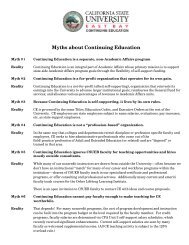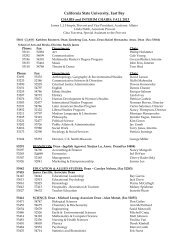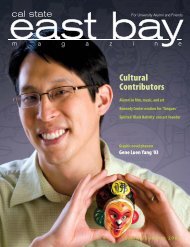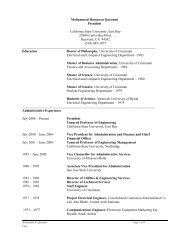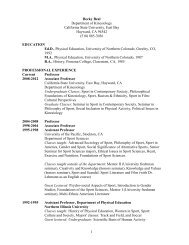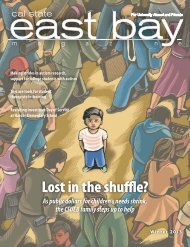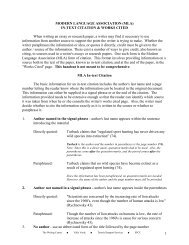Beyond CSI - California State University, East Bay
Beyond CSI - California State University, East Bay
Beyond CSI - California State University, East Bay
You also want an ePaper? Increase the reach of your titles
YUMPU automatically turns print PDFs into web optimized ePapers that Google loves.
A walk to<br />
Remember<br />
The gift of a teaching collection of global art and resources<br />
inspires a vision for “A Walk Through World History” within<br />
the <strong>University</strong> Library as it evolves into a more comprehensive<br />
learning center for the 21 st century.<br />
PHOTO PHILIP RINGLER<br />
An authorized lithograph of Andy Warhol’s<br />
Gold Marilyn, left, highlights American 20 th<br />
century pop art in an art collection donated<br />
to the <strong>University</strong> Library.<br />
BY sarah stanek<br />
“Wait just a moment,” says<br />
Lanier Graham, curator<br />
of art collections for<br />
the <strong>University</strong> Library and<br />
lecturer of art history<br />
since 1993, as he adjusts the<br />
lighting in the Emeritus<br />
Reading Room on the<br />
<strong>University</strong> Library’s second<br />
floor. “I want you to get<br />
the full effect here.”<br />
While he speaks, the room<br />
darkens to illuminate a Renaissance<br />
painting of the Madonna and<br />
Child. The small print, with the<br />
Virgin Mary and infant Jesus<br />
cheek-to-cheek, draped in rich red<br />
cloth, is the first chronological<br />
piece in a room showcasing ways<br />
to introduce different teaching<br />
models into the library. The display<br />
is the product of a donation from<br />
the Institute for Aesthetic<br />
Development (IAD) to the<br />
<strong>University</strong> in 2010 following<br />
decades of collaboration, including<br />
several installations at the<br />
<strong>University</strong> Art Gallery.<br />
The gift, including hundreds<br />
of original artifacts, museumquality<br />
replicas, limited edition<br />
lithographs, artist’s workbooks,<br />
and art reference books, represents<br />
global art from the Stone Age<br />
through the Bronze Age to today.<br />
With pieces from almost every<br />
continent and cultural art tradition<br />
— including African masks,<br />
Tibetan silver statuary, and pop art<br />
— the teaching collection lays the foundation for “A Walk<br />
Through World History.”<br />
At the moment, it’s a short walk — the one-room pilot<br />
exhibit is limited to a sampling of European art from the<br />
collection. But Graham and <strong>University</strong> Librarian Linda<br />
Dobb see possibilities for a pathway through study rooms<br />
and public galleries connecting prehistoric art to the rise of<br />
realism and the abstract representations of the modern era.<br />
“We envision many different types of learning spaces<br />
within the library, not all of them traditional,” says Dobb.<br />
“Exhibits like this absolutely fit with our vision of what a<br />
modern university library and learning center can be.”<br />
Support for a “new century learning center” is a priority<br />
in the <strong>University</strong> of Possibilities comprehensive fundraising<br />
campaign. In addition to modernizing library spaces to<br />
provide more technological connections and collaborative<br />
areas, Dobb says she’d welcome more interactive teaching<br />
exhibits and spaces to display art and artifacts belonging to<br />
the <strong>University</strong>, including the IAD collection. “These are<br />
ways a good library becomes a great library,” she says.<br />
A broad teaching collection like this one is particularly<br />
valuable to the <strong>University</strong>, as pieces can be displayed in<br />
different contexts, such as by geographic origin or time period.<br />
This invites deeper inspection and interaction from students.<br />
“Slides and books are good tools,” Graham says. “But<br />
teaching with actual art is better.”<br />
The key, he explains, is that each gallery has an<br />
authentic centerpiece. “A collection with<br />
all reproductions doesn’t give the full<br />
aesthetic experience,” he says. In this<br />
model, each period or cultural tradition is<br />
represented by selected originals, such as<br />
Egyptian scarab carvings and terracotta<br />
artifacts, with museum-quality replicas of<br />
larger statues and hieroglyphs giving<br />
additional context.<br />
When fully realized, “A Walk through<br />
World History” will complement survey<br />
courses in art and art history, world<br />
history, anthropology, religious studies,<br />
education, and continuing studies. In fact,<br />
it’s already begun serving its educational<br />
purpose. In designing and arranging the<br />
“<br />
We envision many different<br />
types of learning spaces<br />
within the library, not all of<br />
them traditional … These<br />
are ways a good library<br />
becomes a great library.<br />
”<br />
Linda Dobb<br />
An iconic image of Shiva, above, is a bronze<br />
replica of a 12 th century statue from the Chola<br />
Dynasty in southern India.<br />
nascent display, Graham worked with Daniel Charm, Lisa<br />
King, and Joan McLoughlin, graduate students in the<br />
<strong>University</strong>’s certificate program in Art Museum and<br />
Gallery Studies.<br />
Back in the darkened reading room, Graham moves<br />
clockwise from the Madonna to the later Renaissance,<br />
represented by richly illuminated manuscripts and a fresco<br />
replica — two of the primary media during the era.<br />
Continue turning, and the crisp edges of the Baroque<br />
period blur into 19 th -century impressionism. Completing<br />
the circle, he arrives at the more angular 20 th -century<br />
modernist pieces.<br />
And, pointing back to the corner of<br />
the room dedicated to Leonardo da<br />
Vinci, Graham notes that the Renaissance<br />
great was not only an artist but also a<br />
scientist and engineer — a neat<br />
connection between the <strong>University</strong>’s<br />
STEM education initiative and the arts.<br />
It’s the type of integration that<br />
characterizes Cal <strong>State</strong> <strong>East</strong> <strong>Bay</strong>’s<br />
approach to a 21 st -century education and<br />
a 21 st -century library. As Graham says,<br />
“The Wisdom Traditions of the world<br />
PHOTO PHILIP RINGLER<br />
<strong>University</strong> Librarian<br />
teach that it is only when we use both<br />
logic and intuition equally on a regular<br />
basis that we can reach the fullness of<br />
our humanity.” n<br />
friends<br />
42 Cal <strong>State</strong> <strong>East</strong> <strong>Bay</strong> Magazine | SPRING 2011<br />
Cal <strong>State</strong> <strong>East</strong> <strong>Bay</strong> Magazine | SPRING 2011<br />
43





